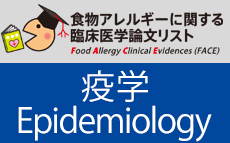ピーナッツの限界量:ピーナッツを負荷し検討した報告からみたピーナッツアレルギーのリスクの特徴/Threshold dose for peanut: risk characterization based upon published results from challenges of peanut-individuals.
更新日:2016年10月21日
| Author: | Taylor SL, Crevel RW, Sheffield D, Kabourek J, Baumert J. |
|---|---|
| Title: | Threshold dose for peanut: risk characterization based upon published results from challenges of peanut-individuals. |
| Citation: | Food and Chemical Toxicology. 2009 Jun;47(6):1198-1204. |
| URL: | https://pubmed.ncbi.nlm.nih.gov/19232533/ |
| Abstract: | Population thresholds for peanut are unknown. However, lowest- and no-observed adverse effect levels (LOAELs and NOAELs) are published for an unknown number of peanut-allergic individuals. Publications were screened for LOAELs and NOAELs from blinded, low-dose oral challenges. Data were obtained from 185 peanut-allergic individuals (12 publications). Data were analyzed by interval-censoring survival analysis and three probability distribution models fitted to it (Log-Normal, Log-Logistic, and Weibull) to estimate the ED(10). All three models described the data well and provided ED(10)'s in close agreement: 17.6, 17.0, and 14.6 mg of whole peanut for the Log-Normal, Log-Logistic, and Weibull models, respectively. The 95% lower confidence intervals for the ED(10)'s were 9.2, 8.1, and 6.0mg of whole peanut for the Log-Normal, Log-Logistic, and Weibull models, respectively. The modeling of individual NOAELs and LOAELs identified from three different types of published studies - diagnostic series, threshold studies, and immunotherapy trials - yielded significantly different whole peanut ED(10)'s of 11.9 mg for threshold studies, 18.0mg for diagnostic series and 65.5mg for immunotherapy trials; patient selection and other biases may have influenced the estimates. These data and risk assessment models provide the type of information that is necessary to establish regulatory thresholds for peanut. |
| 邦文タイトル: | ピーナッツの限界量:ピーナッツを負荷し検討した報告からみたピーナッツアレルギーのリスクの特徴 |
| 一般向け要約 | ある集団でのピーナッツの限界量についての報告はないが、ピーナッツアレルギー患者に対し、「アレルギー症状が誘発される最少量(LOAELs)や誘発されない最大量(NOAELs)」に関しては報告がある。盲検化した低用量の経口負荷試験を施行し、LOAELsやNOAELsについて報告している論文を選び出した。12個の文献から、185人のピーナッツアレルギー患者に行われたデータを集積して、ED10(ピーナッツアレルギー患者全体の10%にアレルギー症状が出現する場合のピーナッツ蛋白の量)を推定した。ED10は14.6~17.6mgであった。NOAELs や LOAELsは、①診断としては18.0mg、②限界量としては11.9mg、③経口免疫療法の研究としては65.5mg、という各々の目的で行った経口負荷試験でのピーナッツED10にばらつきが大きかった。これは患者選択や他のバイアスが推定値に影響した可能性がある。 |
| 専門医コメント | ピーナッツアレルギーはしばしば重症となりしかも食物アレルギー全体の約3%ほどを占めるとも言われています。アレルギー症状が出るギリギリの量を把握するための様々な研究が行われていますが、どのような人たちを集めて調べたかによって大きく異なる結果が報告されています。。今後一般人口に近い集団を対象にした調査が求められています。 |

